The Huawei Mate 8 Review
by Andrei Frumusanu on January 5, 2016 1:00 PM EST- Posted in
- Mobile
- Smartphones
- Huawei
- Cortex A72
- Kirin 950
- Mate 8
- CES 2016
Battery Life
Continuing to the battery life benchmarks we should expect the Mate 8 to perform very well, thanks to the high efficiency of the Kirin 950, an LCD screen as well as the 4000mAh / 15.2Wh large battery.
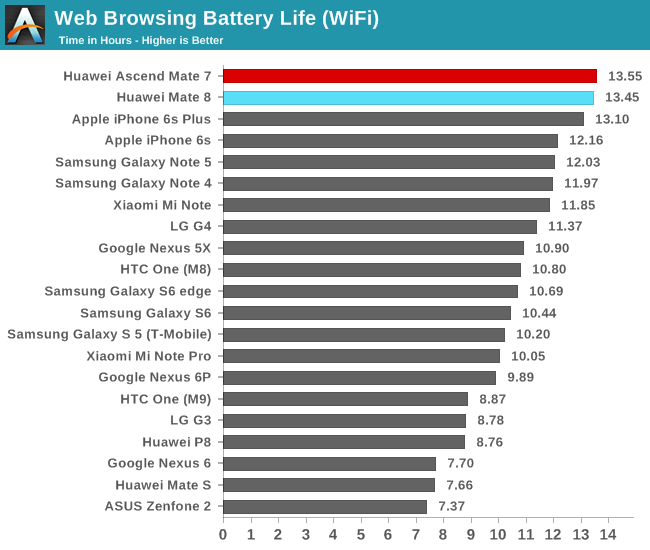
Starting off with our WiFi web-browsing test we see the Mate 8 just get short of 13.5h of battery life. The interesting comparison is here to last year’s Mate 7 as it seems the actually last just as much. This may point out that the screen efficiency measured in our display power testing was maybe correct and the Mate 8 is less efficient. Another aspect is that the Mate 8’s overall platform power consumption hasn’t seen much improvement and thus still represents a large barrier for battery life.
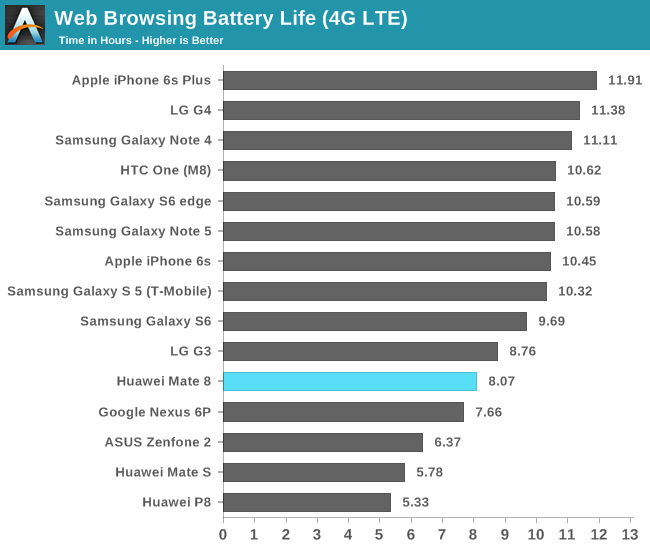
On the 4G LTE test we see that the Mate 8 loses out its advantage over the competition. Again I’m testing under rather mediocre signal conditions so it’s not a valid apples-to-apples comparison to devices reviewed by Joshua or Brandon, however when comparing it against for example such as the Nexus 6P which was tested under the same conditions we see that the Mate 8 faces a much larger battery life degradation going from the WiFi to the LTE test. The reason for this can only be that the Kirin 950’s modem and RF back-end just aren’t as efficient as Qualcomm or even Samsung’s.
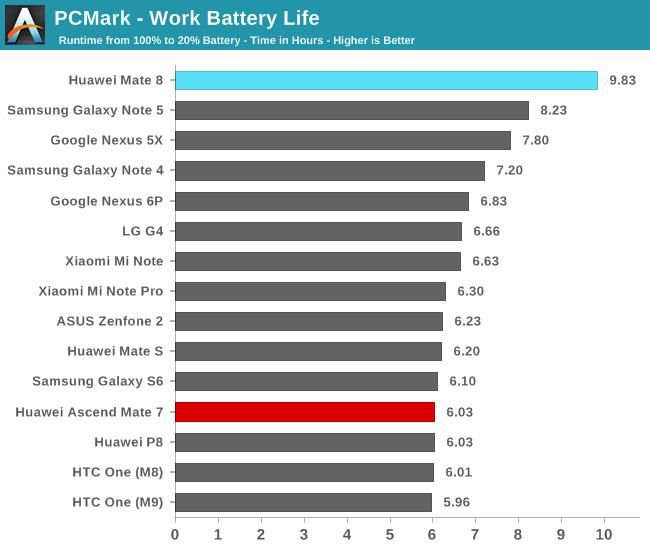
While the web-browsing tests didn’t represent a large improvement for the Mate 8, we see PCMark put the phablet as the current undisputed leader among high-performance devices. Here the difference to the Mate 7 is almost 4 hours, or around a 65% increase in battery life. The increase is most certainly linked to the new SoC’s power efficiency.
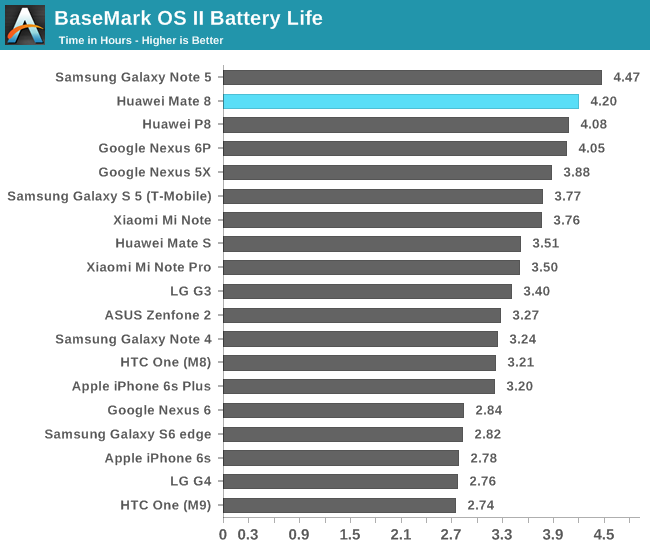
BaseMark OS II’s battery test is more of a maximum load type test that depends on the allowed maximum TDP of the phone. With a 15.2Wh battery and a runtime of 4.2h we see an average consumption of 3.6W, roughly the same amount of power that I saw that the device was able to sustain in our CPU thermal test.

Finally the GFXBench battery test shows that the Mate 8 doesn’t show very good battery life but this is a two-edged sword. As we’ve seen in the GPU section the SoC hardly throttles under heavy GPU load and thus retains its maximum performance for the duration of the test. Considering that the Mate 7 slowed throttled down to 9-10fps and the Mate 8 does not go under 40fps, it still shows that the Mate 8 is twice as efficient as the Mate 7 even though overall battery life is almost twice as short.
At 200 nits the Mate 8 averages an idle power consumption of 989mW and we saw that system load power for the T-Rex test is 3.64W. 3 hours battery runtime averages 5W of power, near the 4.6W we theorized. The small difference may be due to the overhead of actually running the on-screen test and thus also not able to show the DDIC’s savings thanks to PSR due to continuously changing screen content.
Overall I’ve been extremely impressed by the Mate 8’s battery life. In everyday usage this is the longest-lasting device I’ve had the opportunity to use. The Kirin 950’s efficiency is outstanding and is truly able to earn its place among the top for this generation. It seems the Mate 8’s limiting factors are related to the screen and general platform base power consumption, something that Huawei may be able to improve in future devices and thus get even better value out of the Kirin 950.
All being said, if you’re looking for a long-lasting device, you can’t go wrong with the Mate 8.
Charge Time
The Mate 8 advertises fast charging out of the box so that even considering it having a large 4000mAh battery, it should still be fast to fill up when in need. The stock charger is a 9V/2A (18W) unit. I’m not sure if the charging enumeration protocol is based on Quick Charge or Adaptive Fast Charging, but it was able to enable fast-charging on Samsung phones while the Mate 8 didn’t fast-charge on Samsung’s charger, meaning the Huawei charger is likely a Quick Charge unit and the Mate 8’s PMIC and voltage negotiation IC seems to only accept Quick Charge.
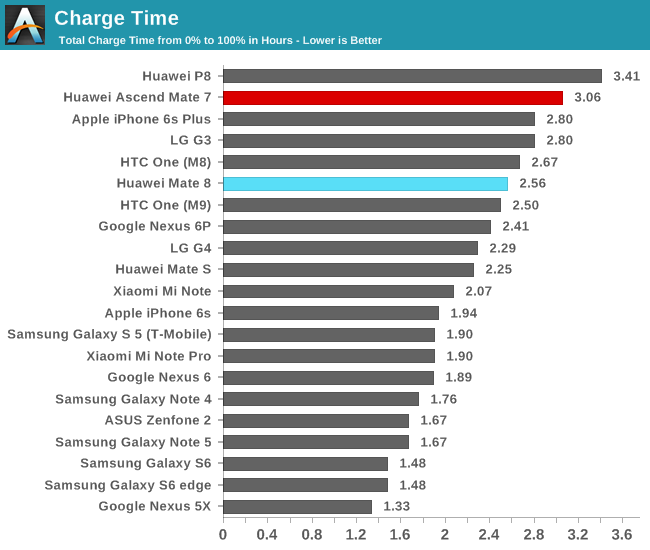
As we see in the charge graph, the Mate 8’s battery cell gets charged at up to 11.5W during the fast-charging phase, being able to reach 80% in 68 minutes around little under 40% charge for each half hour of charging. The last 20% takes up to another 70 minutes as the device switches over to trickle-charging.
While the Mate 8 ends up with total charge time of 2.56 hours, what counts is that the initial 80% of battery capacity can be charged very fast so the Mate 8 is no slouch in this metric.


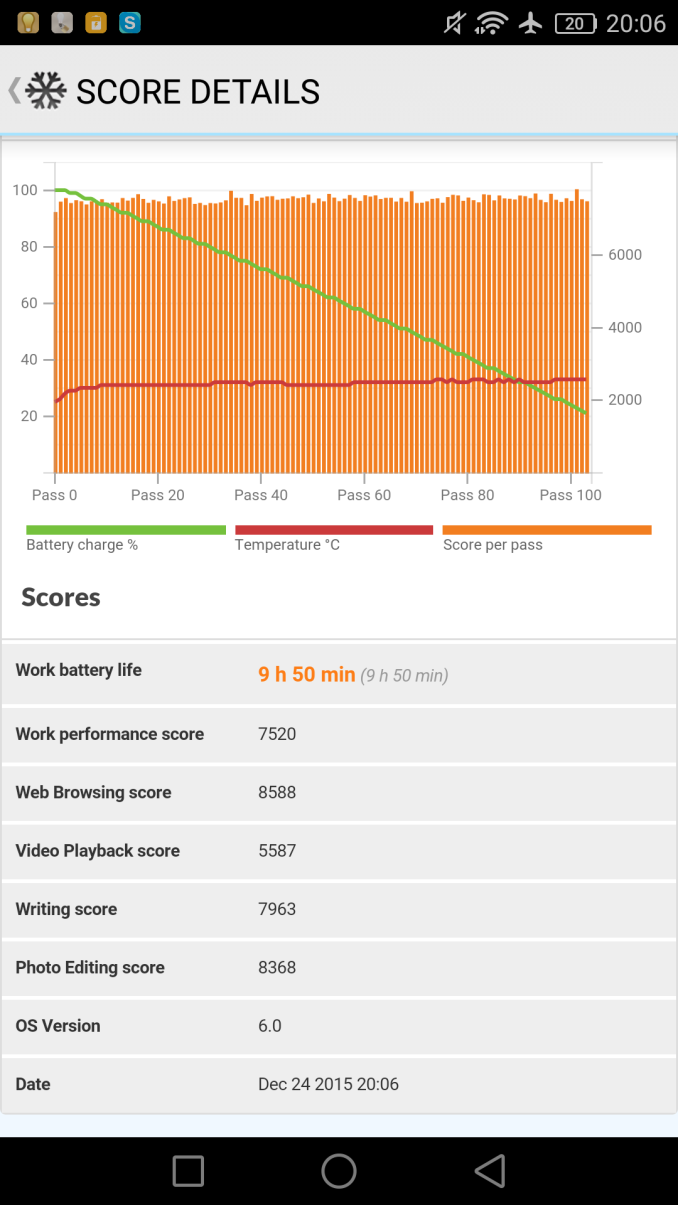
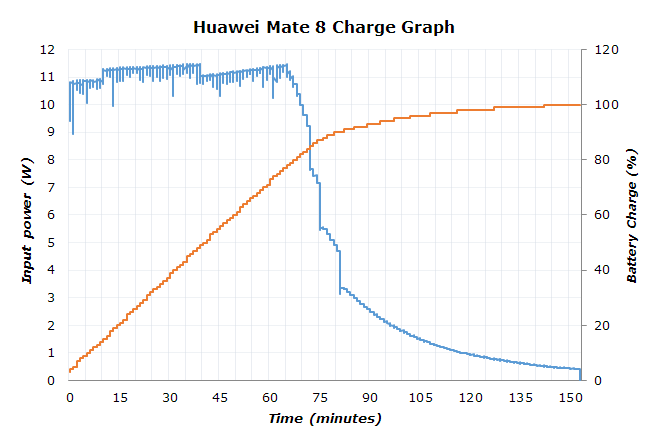








116 Comments
View All Comments
darkich - Wednesday, January 6, 2016 - link
Wow, the efficiency of the A72 seems the best out of any CPU.If I'm not mistaken, it consumes less than 50% of what the Apple Twister in iPhones needs
name99 - Wednesday, January 6, 2016 - link
Read my comments above.The SPEC numbers seem tainted and untrustworthy. I wouldn't trust them in the slightest until AnandTech (or someone else) has had a chance to validate them. In particular the vpr number still seems unlikely.
As for your efficiency of A72, I don't know where you're getting that claim from. In particular the sort of fine-grained per-core power data needed to make the determination has not been made available for iOS. The best we can do is macro-level tests like the WiFi and LTE battery life tests, and obviously iPhone does fine on those. (Which is not to denigrate ARM/TSMC/Huawei's achievement --- this does look like a very nice CPU, unlike the somewhat more problematic A57.)
Andrei Frumusanu - Wednesday, January 6, 2016 - link
I made sure all the tests passed validation so the scores should be correct this time around.fackamato - Wednesday, January 6, 2016 - link
Disappointed to not see the OnePlus 2 in the benchmarks, seeing as it's a dual SIM phone as well.zeeBomb - Wednesday, January 6, 2016 - link
Well damn. I should have woke up early to read this review.kadeep - Wednesday, January 6, 2016 - link
Iphones appear in charts only when they are ahead lolEthos Evoss - Wednesday, January 6, 2016 - link
What smartphone sites and reviewers doing wrong is comparing two completely different systems which is VERY WRONG and misleading to the ppl on internet !!!It is simply inapplicable ! If Apple would manufacture their iphone with android system then their pone wouldn't even start .. ! And it would be MEGA slow But IF iOS for iphone would be on an android (latest) device , you would not even realize when the phone iOS booted to home screen..
That is the FACT ! The main reason is that android is and true operating system where are 5x more processes than on poor simple iOS which is just the ''shell'' system.. there are no many processes in background as on android system.. android is linux which is VERY VERY similar to Desktop PC linux.. AND THAT is WHY Apple DENIED put iphone's iOS onto MACs or MacBook PROs or OSX onto iphones !!
There is ''behind the scenes'' big game around and about this ''secret'' Apple's software but unfort. many ppl HAS NO IDEA unfortunately ! ..
TheinsanegamerN - Wednesday, January 6, 2016 - link
You appear to have misplaced your tinfoil hat. There is no reason android wouldn't run on an iPhone if Apple decided to do that. Literally no reason. It also wouldn't be MEGA slow, since the a9 is one of the finest SoCs ever made. The rest of your post appears to be uninformed dribble and garbage.Ethos Evoss - Wednesday, January 6, 2016 - link
OK u unknowledged person I won't be even bothering with you .. who DOESN'T understands the reality which is in the world.. A9 finest ? pleease .. you are so stupid bcos u believe media and advertise marketing.. and maybe fake benchmarks when it comes to iphone .. such common person you are.. live you in your dreams.. ;)osxandwindows - Wednesday, January 6, 2016 - link
Well, since you claim that the tests for the a9 are fake, you mind sharing tests of your own?